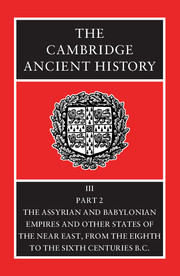Book contents
- Frontmatter
- Contents
- List of maps
- List of text-figures
- Preface
- PART I ASSYRIA AND BABYLONIA
- PART II THE EASTERN MEDITERRANEAN AND THE BLACK SEA
- 29 Israel and Judah from the coming of Assyrian domination until the fall of Samaria, and the struggle for independence in Judah (c. 750–700 B.C.)
- 30 Judah until the fall of Jerusalem (c. 700–586 B.C.)
- 31 The Babylonian Exile and the restoration of the Jews in Palestine (586–c. 500 B.C.)
- 32 Phoenicia and Phoenician colonization
- 33 Scythia and Thrace
- 33a The Scythians
- 33b Thrace before the Persian entry into Europe
- 34 Anatolia
- 35 Egypt: the Twenty-fifth and Twenty-sixth Dynasties
- Chronological Table
- Note on The Calendar
- BIBLIOGRAPHY
- Index
- Map 11: Phoenician and Punic sites in Spain
- Map 13: Scythia
- Map 14: Thrace
- References
33b - Thrace before the Persian entry into Europe
from 33 - Scythia and Thrace
Published online by Cambridge University Press: 28 March 2008
- Frontmatter
- Contents
- List of maps
- List of text-figures
- Preface
- PART I ASSYRIA AND BABYLONIA
- PART II THE EASTERN MEDITERRANEAN AND THE BLACK SEA
- 29 Israel and Judah from the coming of Assyrian domination until the fall of Samaria, and the struggle for independence in Judah (c. 750–700 B.C.)
- 30 Judah until the fall of Jerusalem (c. 700–586 B.C.)
- 31 The Babylonian Exile and the restoration of the Jews in Palestine (586–c. 500 B.C.)
- 32 Phoenicia and Phoenician colonization
- 33 Scythia and Thrace
- 33a The Scythians
- 33b Thrace before the Persian entry into Europe
- 34 Anatolia
- 35 Egypt: the Twenty-fifth and Twenty-sixth Dynasties
- Chronological Table
- Note on The Calendar
- BIBLIOGRAPHY
- Index
- Map 11: Phoenician and Punic sites in Spain
- Map 13: Scythia
- Map 14: Thrace
- References
Summary
SOURCES
The sources for this period are neither rich nor of a consistent value. Of contemporary literary sources we have first the evidence of the Homeric poems, then some very scanty passages in Hesiod, a few fragments of lyric poets such as Archilochus and Alcaeus, to which may be added some data, fragmentary and imprecise, in the logographers, especially Hecataeus. The historians Herodotus and Thucydides provide valuable, if limited, information. In later Greek and Latin literature can be found statements directly bearing on our period, for example in Aristotle or Strabo, or in the scholia of Homer or of Apollonius Rhodius. There are in addition indirect literary references; they are concerned with later events, but show a process of evolution from earlier times. To this first category of sources should be added the material evidence provided by archaeologists, which is, however, in itself not very rich.
A GEOGRAPHICAL SUMMARY
After the migradons during the second half of the second millennium and the first centuries of the first millennium, the Thracians were settled in an extensive area stretching from the Euxine (Black) Sea to the neighbourhood of the Axius (Vardar), and from the Aegean Sea to the Transdanubian lands (below, Section IV). They straddled the Propontis (the Sea of Marmora), and had a foothold also in the Troad and in Bithynia.
- Type
- Chapter
- Information
- The Cambridge Ancient History , pp. 591 - 618Publisher: Cambridge University PressPrint publication year: 1992

